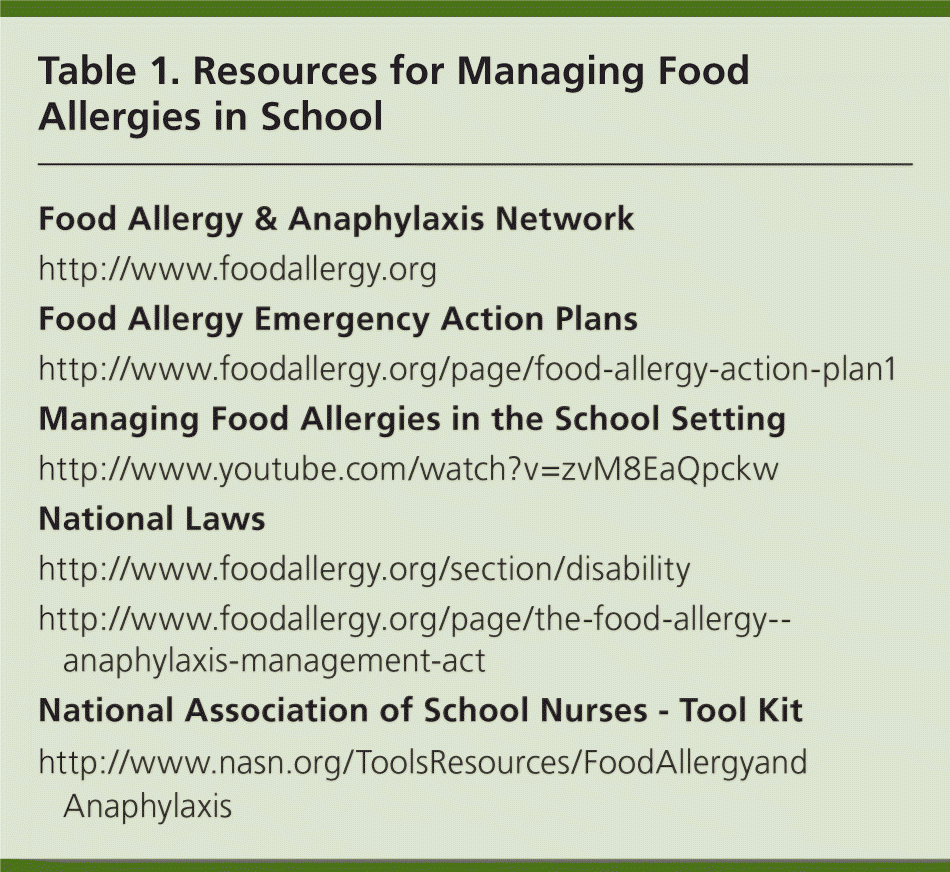
This is a corrected version of the editorial that appeared in print.
Am Fam Physician. 2012;86(1):16-18
Author disclosure: No relevant financial affiliations to disclose.
For children with potentially life-threatening food allergies, the school environment can present significant management challenges. A substantial proportion of food allergy reactions occur in school, and these reactions can be fatal.1,2 Over a two-year period, schools can expect that approximately 18 percent of students with food allergies will have at least one reaction in school.3 [ corrected] Although there are no specific data on fatalities in school settings, the estimated incidence of fatal food-induced anaphylaxis is one episode per 800,000 children per year.4 The groups at higher risk of fatalities secondary to food allergy are adolescents and persons with asthma.5
The food allergy guidelines sponsored by the National Instititue of Allergy and Infectious Diseases cite a recent study that reveals a significant percentage of children with food allergies do not have access to epinephrine at school.6 Given that most children spend a significant amount of time in school, the proper management of food allergies in the school setting is critical. The guidelines also highlight that most preschool-aged children with peanut and tree nut allergies will not outgrow them. Therefore, proper prevention and preparedness methods are important as the child transitions to the school environment.
It is important to work with parents to identify the guidelines and resources available at the child’s school. Many schools may not have a nurse on site. In these cases, the parents may be directed to the principal as a primary contact. All adults supervising the student (e.g., teachers, coaches, aftercare providers) should be informed and trained in the use of the prescribed epinephrine autoinjector in the event of an allergic reaction. Fatalities caused by anaphylaxis are often associated with delays in treatment; therefore, it is critical that the adults responsible for the affected child are prepared to act quickly.6
Most experts agree that students with food allergies should have an emergency action plan, similar to those used for students with asthma.7 The plan, filled out by the primary care physician or allergist, provides specific instructions on how to treat the child in the event of an exposure or reaction to the food allergen. An example of a food allergy emergency action plan is available from the Food Allergy & Anaphylaxis Network8 (Table 1). To help with care transitions, we recommend that a copy of the student’s plan with an epinephrine autoinjector be placed in the nurse’s or principal’s office, and another copy of the plan with an additional autoinjector be placed where the child will be after school. Teachers, substitutes, and coaches should review and always have immediate access to the student’s action plan and epinephrine. Most states allow the child to carry his or her own autoinjector; however, the primary care physician must take into account the maturity of the child when deciding if this is an option.9

| Food Allergy & Anaphylaxis Network |
| http://www.foodallergy.org |
| Food Allergy Emergency Action Plans |
| http://www.foodallergy.org/page/food-allergy-action-plan1 |
| Managing Food Allergies in the School Setting |
| http://www.youtube.com/watch?v=zvM8EaQpckw |
| National Laws |
| http://www.foodallergy.org/section/disability |
| http://www.foodallergy.org/page/the-food-allergy--anaphylaxis-management-act |
| National Association of School Nurses - Tool Kit |
| http://www.nasn.org/ToolsResources/FoodAllergyandAnaphylaxis |
Patient and parent education is important. Unexpected allergens can be found in schools by way of birthday treats and classroom crafts (for example, peanut butter in bird feeders). Primary prevention methods include allergenfree zones (for example, peanut-free cafeteria tables), no food/utensil sharing policies, peer handwashing after meals, and proper food allergen cleanup.10 Bus rides, field trips, and after school activities can also be challenging. In the event of a field trip, a trained staff member who has the child’s emergency action plan and epinephrine should be with the student at all times. In addition, epinephrine should be protected from extreme temperatures. For example, it cannot be left in a hot vehicle.
Persons with food allergies are covered under the Rehabilitation Act of 1973 and the Americans with Disabilities Act of 1991. Additionally, in 2011, the Food Allergy & Anaphylaxis Management Act was signed into law, which calls for the creation of national school guidelines.11 At present, however, guidelines can vary depending on the state and the school district.
Proper management of food allergies in the school setting can be challenging, but it is critical to good outcomes. Clinicians and parents should be aware of resources available to aid in successfully managing food allergies in schools (Table 1).
